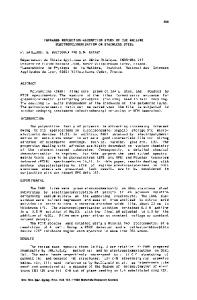Infrared Absorption Study of Zinc-Doped Silicon.
- PDF / 361,631 Bytes
- 6 Pages / 420.48 x 639 pts Page_size
- 20 Downloads / 347 Views
INFRARED ABSORPTION STUDY OF ZINC-DOPED SILICON. E. MERK, J. HEYMAN and E. E. HALLER Center for Advanced Materials, Materials and Chemical Sciences Division, Lawrence Berkeley Laboratory, and University of California Berkeley, CA 94720.
ABSTRACT We report high resolution infrared absorption spectra associated with the deep zinc acceptor in silicon. The optical transitions between ground and bound excited "p-like" states of the neutral helium-like double acceptor Zn0 center have been observed for the first time. The absorption cross section for the hole transition is found to be very small, of the order of 10-17 cm 2 . Energy spacings of the P 3/2 Rydberg series are very similar to the spacings of the group-Ill acceptors, suggesting that, in spite of the large ground state binding energy, effective mass approximation still applies to the bound excited states. This represents one more case where the strong central cell potential does not significantly disturb the neutral helium-like bound excited states. Similar observations have been made for the less deep neutral double acceptor Be, and for the chalcogens donors S, Se and Te. The optical ionization energy of Zn0 '- has been determined to be 2575 cm-1 (319 meV). Two additional sets of absorption lines related to zinc have been observed at 2130cm-1 and 2758 oar1. Their origin will be discussed.
INTRODUCTION The knowledge of the electronic structure of group-LI impurities in silicon lags behind our understanding of these impurities in germanium [ 1-41. This is in part related to the fact that in silicon the group-II impurities give rise to much deeper, more localized electronic states in the bandgap compared to the case of germanium. In addition the concentration of electrically active gnxip-ll acceptors lies around 1016cnrr 3, a factor of 100 smaller than in Ge. In combination these properties make the observation of line spectra originating from ground to bound excited state transitions much more difficult in Si than in Ge. Indeed most of the levels related to group-II
impurities in silicon have been determined from resistivity and Hall effect measurements or junction space charge techniques, e.g. Deep Level Transient Spectroscopy (DLTS). The activation energies of the two charge states of the double acceptor zinc were determined as early as in the late fifties [5,6] to be E,+0.31 eV for the first ionization stage and Ec-0.55 eV for the second one. Since that time and despite numerous attempts, no structured absorption features due to bound hole transitions were reported [7]. In this work we report the first observation of bound to bound transitions in the neutral double acceptor Zn in silicon which allows an accurate determination of its optical activation energy.
Further motivation for this work is related to an interest in the study of the mechanism of hydrogen passivation of a double acceptor which are expected to become partially or fully passivated. Preliminary results of hydrogen passivation of zinc in silicon are presented: a new complex related to zinc
Data Loading...






